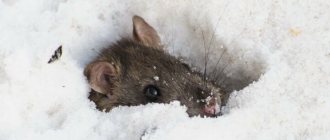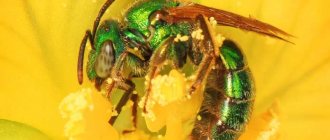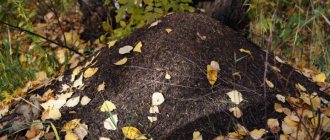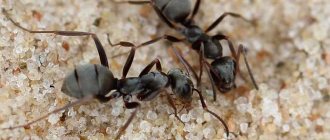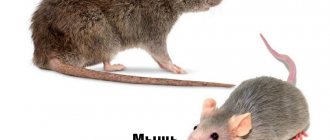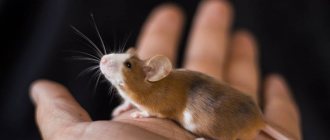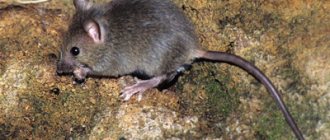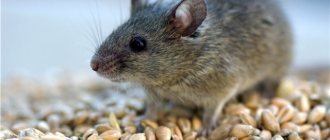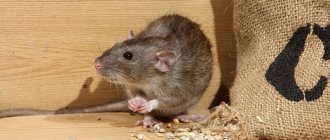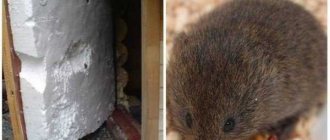Rodents are the richest order of mammals in terms of species diversity. Their characteristic feature is large incisors on the upper and lower jaws. The way of life, the functions performed by various parts of the body, and habitats determine the appearance of the various representatives of this order. The mass of rodents can range from five grams to several tens of kilograms.
Mammals of this order are found throughout the world. Where they did not exist, rodents were brought in specifically for various purposes. The only exceptions are the Antarctic region and some islands.
Family Gilts
Gilts live exclusively in South America in its most diverse climatic zones.
Representatives of this family have an elongated body, four-toed forelimbs and three-toed hind limbs, a short tail and neck, and a large head. Ears may be short, long, or absent altogether. The hairline is usually rough. The fur on the back is brown, gray, black or olive. The belly is light: color from white to dark yellow. Some species are nocturnal, others diurnal. However, none of them hibernate.
The family consists of 5 genera, which are represented by 15 species.
Abyssinian guinea pig
Peruvian guinea pig
Brazilian pig
Guinea pig
Squirrel family
The family is divided into 5 subfamilies containing approximately 230 species. The most famous are the squirrel and the gopher.
Rodents of this family are widespread on all continents with the exception of Australia and Antarctica. A number of Arctic and tropical islands are also not inhabited by Squirrels.
These rodents can be small or large. Body length varies between 6-70 cm. Weight ranges from a few grams to 9 kg. All have a long tail covered with fur. Squirrels have strong, developed limbs and large eyes. The hair color can have stripes, spots or be one color: red, black, white, etc.
Chipmunk squirrel
prairie dog
Magellan tuco-tuco
Little chipmunk
Little gopher
Palm squirrel
References
This article is based in whole or in part on German Wikipedia, March 8, 2012.
Notes
- ^ [a b] Wilson and Reader, eds. (2005). "Rodentia (and subordinate pages)" (in English). Species of Mammals of the World
. Baltimore: Johns Hopkins University Press. ISBN 0-8018-8221-4 - ^ [a b cd f g gram clock] McDonald, D. W. (2009) "Rodents", pp. 128–139.
- ^ [a b cd f g] Novak, R. M. (1999), pp. 1243-44
- Novak, R. M. (1999), p. 1622
- Novak, R. M. (1999), pp. 1504-05.
- Novak, R. M. (1999), pp. 1604-08. partially online
- Novak, R. M. (1999), pp. 1672-74
- Science writers describe a giant rodent, Phoberomys patersoni
Archived February 11, 2012, retrieved from the Wayback Machine.. American Association for the Advancement of Science, read March 20, 2012. - Nowak, R. M. (1999), pp. 1423/25 golden hamsters ( Mesocricetus
) - Tirira, D., Vargas, J. & Dunnum, J. 2011. Dinomys branickii
From: IUCN 2010.
IUCN Red List of Threatened Species
. Version 2010.4. www.uucnredlist.org>. Read March 24, 2012. - R. Buffenstein and J.W. Jarvis: Naked mole rat sets a new record for the oldest living rodent
- Novak, R. M. (1999), pp. 1667/69 partially online
- Novak, R. M. (1999), pp. 1650/51 online
- E. Saljo “Glirarium” (English translation). In Daremberg und Saglio, Dictionnaire des Antiquités Grecques et Romaines
, Volume II (Vol. 2), pp. 1613, Librairie Hachette et Cie., Paris, 1877–1919. - Top 10 animal astronauts, toptenz.net, read March 24, 2012
Printed sources
- Ronald M. Novak: Walker's Mammals of the World
. 6 editions. Johns Hopkins University Press, Baltimore 1999, ISBN 0-8018-5789-9. - David W. McDonald, editor (2009) (in English). Encyclopedia of Mammals
. Oxford University Press. ISBN 978-0-19-956799-7
Family Hedgehogs
The species composition of this family is not the largest. However, 24 different species are known.
All Ezhovs have a number of characteristics that unite them into one family. These include a pointed, elongated muzzle, well-developed eyes and ears, and limbs with five fingers. A distinctive feature of the family is the skin with many needles interspersed with hairs of wool. These rodents also have a special muscle that runs through their entire body. She helps the animal curl up into a ball, escaping from predators.
The habitat of hedgehogs is Central and South Asia, Europe. They were once introduced to islands near Africa, where they spread safely.
Hedgehog
Family Mole rats
Mole rats are burrowing animals that are adapted to life underground. The family is divided into three subfamilies, which include more than 30 species of rodents.
Characteristic features of animals of this family are half-blind eyes, underdeveloped ears, short thick fur, and short limbs. The length of the body of various species can be from 0.13 to 0.48 m, and weigh from 100 g to 4 kg. Some species have powerful incisors with which they dig the ground. Other rodents use their front paws for this.
Mole rats live in Europe, Asia, and northeast Africa. They are also found on Russian territory.
Small bamboo rat
Lesser mole rat
Family Jerboa
These rodents live in desert, semi-desert, steppe, and low mountain areas. They inhabited northern Africa, some parts of Europe, Asia, Kazakhstan, southern Siberia, etc.
These mammals have a short body, elongated hind legs, and short forelimbs, with which they remove the earth dug out with their incisors. The size of these rodents is 4-25 cm, weight no more than 300 g. All species have a very long tail, which serves as a rudder and balancer when running. These animals have a short neck, a large head, long rounded ears and a uniform skin of beige-brown shades.
Jerboas, with rare exceptions, are nocturnal. They dig burrows, feed on plants and insects, and bear offspring one to three times a year.
Small jerboa
Desert jerboa
Family Gerbils
Gerbils are small rodents that look like mice. They can reach 20 cm in length depending on the species. Their weight ranges from 10 to 225 grams. These animals have a long tail, rather large eyes, and protruding ears. The color of their fur is unremarkable: the back is sandy or brown, and the belly is light.
The habitats of these rodents are desert, semi-desert, and steppe areas. They are widespread in Central Asia, Kazakhstan, and also in Africa. They are found in the smallest quantities in the Caspian region and Transbaikalia.
Gerbil Sundevalla
Sand mole rat
Content
- 1Overall
- 2Distribution and habitat
- 3Appearance and anatomy 3.1General physique
- 3.2 Teeth
- 3.3Skeleton
- 4.1Social behavior and activity
- 5.1 Subordinates and families
- 6.1Rodents as useful animals
- 7.1Notes
The structure and appearance of rodents
The majority of rodents are relatively small in size. But among them there are small and large animals: from a dwarf mouse weighing 7 g and 3 cm long to a ninety-kilogram capybara, reaching up to 130 cm in length. Rodents usually have such a long tail that it can be twice or even three times as long as their body. But in many representatives of the Miguels this organ may be completely absent. Animals of this order can have different body shapes. It depends on what kind of life is inherent in a particular clan. For example, for those who have to move a lot from place to place, sometimes even jumping, the hind limbs in the process of evolution have become much longer than the front ones. This applies to Tushkanchikovs and Belichichs. Those who need to dig holes for shelter and search for food need strong front paws with powerful claws and a rounded body shape.
The anterior incisors in rodents are enlarged and separated from the chewing teeth by a diastema. They have the ability to self-sharpen. Rodents also have no fangs at all. The skeleton of mammals is represented by a spine with 30 main vertebrae and an individual number of tail vertebrae, four limbs, a massive skull, and large eye sockets. The number and size of bones depend on the specific representative.
The body of rodents is covered with hair, usually of equal length and not very striking colors. In some of them, the hairs have formed into needles (the Hedgehog family). On the front part of the animals there are vibrissae, which perform the function of touch.
Characteristics and features
Rodents appeared on the planet more than 60 million years ago and have evolved greatly since then. Some species developed and changed, others completely disappeared.
Representatives of the rodent order inhabit a wide variety of climatic zones, living in warm and cold, wet and dry places, near water bodies and deep in forests, on plains and in mountainous areas. They live on the ground, underground, in trees, in swamps. And some species have even mastered the airspace, for example, the flying squirrel.
Various rodents exhibit vital activity either at night and twilight, or during the daytime.
These mammals can exist in groups with different numbers of individuals or be solitary. Their brain is quite large in size and does not have convolutions on its surface. Rodents are quite smart animals, they can perform the simplest actions, they have their own language for communication.
Well-developed sensory organs responsible for tactile sensations, hearing and smell enable rodents to recognize danger in time and avoid it, communicate with their own kind, find food and everything necessary for existence.
Rodents have elongated intestines. This is due to the consumption of food mainly of plant origin.
Natural enemies of gray squirrels
Photo: Rodent gray squirrel
This species still does not have many enemies, which explains the rapid population of Europe, like other rodents. They are saved by their speed of movement, sensitive hearing and excellent reaction. You can only catch a squirrel on the ground, where it spends very little time. Most often, she becomes a victim of foxes and wolves, who patiently guard their prey. In the trees it is hunted by martens, wild cats and lynx.
In open areas, it is easy prey for birds of prey: eagle, falcon and kite. A crow or an ordinary domestic cat can steal small squirrels from a nest. Over the course of generations, the gray squirrel has “developed” its survival strategy. For example, running up and down and in spirals makes it very difficult for birds of prey to catch prey. And using thin branches to move, the gray squirrel can easily escape from the marten.
The natural enemies of the gray (Carolina) squirrel in America are:
- coyote;
- gray foxes;
- young wolves;
- eagle;
- golden eagle;
- owls;
- American marten;
- piranha;
- puma;
- goshawks.
As can be seen from the list, more than half of these predators are missing in Europe, which immediately affected the squirrel population. She can easily jump away from her pursuer to a great distance. A healthy and strong animal rarely falls into the teeth of a predator. Usually these are sick, weakened or very young proteins. Squirrels compete with chipmunks, mice, and hares for resources and food. But close to humans, the squirrel has almost no enemies; predators are mainly afraid of people, except cats.
Rodent nutrition
The basis of nutrition of these mammals is plant food. They eat leaves, shoots, seeds, berries, gnaw twigs, bark, etc. But not all rodents are only herbivores. There are also omnivores among them, who, along with roots and herbs, eat insects, snails, worms, bird eggs, and small vertebrates (for example, lizards). Species living near water can feed on fish, shellfish and various crustaceans.
Animals spend a significant part of their lives getting food. Some representatives, mainly among Khomyakov, Squirrel and Mouse, store food for the winter in burrows and hollows.
The diet of rodents depends on the seasonality of the year. In summer, food is varied and includes seeds, plant parts, insects, etc. In autumn, berries, fruits and root vegetables. In winter, wood, bark and roots. In spring, the first young shoots and leaves begin to grow, which are necessary for the growth and development of the body.
The weather also affects the diet. In hot weather, rodents forage for food at night, when it is cooler. When daytime temperatures drop, they become active during daylight hours. Weather, age, and place in the hierarchy (for social species) also influence feeding behavior.
You can read what squirrels eat in the forest in winter and summer in a special article -
Taxonomy
- Squirrel: 1—common squirrel; 2—thin-toed ground squirrel; 3—chipmunk; 4—speckled ground squirrel; 5—Mexican prairie dog; 6—Menzbier's marmot.
- Flying squirrels: 7—flying squirrel.
- Gopheraceae: 8—plain gopher.
- Beavers: 9—beaver.
- Long-legged: 10—long-legged.
- Hamsters: 11—common hamster; 12—Djungarian hamster; 13—ordinary zokor; 14—common vole; 15—hoofed lemming; 16—Siberian lemming; 17—water vole; 18—common mole vole; 19—large gerbil.
- Mole rats: 20—common mole rat.
- Mouse: 21—tiny mouse; 22—pasyuk.
- Dormouse: 23—garden dormouse.
- Seleviniaceae: 24—selevinia.
- Mousebirds: 25—wood mouse.
- Jerboa: 26—fat-tailed jerboa; 27—large jerboa.
- Porcupines: 28—Indian porcupine.
- Amer. porcupines: 29—grain-tailed porcupine.
- Guinea pigs: 30—guinea pig; 31—Patagonian mara.
- Capybara: 32—capybara.
- Chinchillas: 33—chinchilla; 34—viscacha.
- Nutriaceae: 35—nutria.
The taxonomy of the order, due to the large number and diversity of its representatives, sometimes having convergent characters, is very difficult and complex.
Until now, there is no consensus among experts even regarding large taxonomic categories (suborders, superfamilies). Order Rodentia (Bowdich, 1821)
is divided into 6 suborders and includes about 1600 species and 29 families.
- suborder Spiked-tailed (Anomaluromorpha) (Bugge, 1974)
family Spiked-tailed (Anomaluridae) (Gervais, 1849) + - family Pedetidae (Gray, 1825) +
suborder Beavers (Castorimorpha) (AE Wood, 1955)
- Beaver family (Castoridae) (Hemprich, 1820) +
family Gopheridae (Geomyidae) (Bonaparte, 1845) + family Pouchhopper (Heteromyidae) (Gray, 1868) +
suborder Porcupines (Hystricognatha) Woods, 1976
- infraorder Porcupines Hystricognathi Brandt, 1855 family Abrocomidae (Miller and Gidley, 1918) +
family Bathyergidae (Waterhouse, 1841) + family Capromyidae (Smith, 1842) + family Caviidae (Fischer de Waldheim, 1817) + family Chinchilladae (Bennett, 1833) + family Tuco-tucaceae (Ctenomyidae) (Lesson, 1842) + family Cuniculidae (Miller & Gidley, 1918) + family Agutiaceae (Dasyproctidae) (Bonaparte, 1838) + family Laotian mountain rats (Diatomyidae) (Mein & Ginsburg 1997) + family Pacaranaceae ( DINOMYIDAE (Peters, 1873) + Family bristly rats (Echimyidae) (Gray, 1825) + Fine is wooden -rocket (Erethizontidae) (Bonaparte, 1845) + Semizubovaya family (Heptaxodontidae) (Anthony, 1917) + Family + Family + Family + Family + Family + Family + Family + Family + Family + Family + Family + Family Zvoil (Hystricidae) (Fischer de Waldheim, 1817) + Nutria family (Myocastoridae) (Ameghino, 1902) + Octodontidae family (Waterhouse, 1840) + Rock rat family (Petromuridae) (Tullberg, 1899) + Thryonomyidae family (Pocock, 1922) +
suborder Myomorpha (Brandt, 1855)
- family Jerboa (Dipodidae) (G. Fischer, 1817) +
family Mouse (Muridae) (Illiger, 1815) + family Dormouse (Myoxidae) (Gray, 1821) +
suborder Comb-mouse-like (Sciuravida)
- family Gundiaceae Ctenodactylidae Gervais, 1853 +
suborder Squirrel-like (Sciuromorpha) (Brandt, 1855)
- family Aplodontiidae (Brandt, 1855) +
squirrel family (Sciuridae) (Fischer de Waldheim, 1817) +
Reproduction of rodents
Animals of this order are very prolific. Females of small species can have several litters per year: from two to five. Moreover, each litter usually contains several cubs at once. The quantity varies from 5 to 15 pieces. And larger representatives of the order give birth once a year and no more than three cubs.
Some species give birth to underdeveloped young that require long-term care. And there are some animals that, after birth, are almost immediately ready to move independently.
Not only the number of annual litters varies greatly among species, but also the duration of pregnancy. In small animals it is short - only 18-20 days. And the larger the animal, the longer the pregnancy lasts. Muskrats, for example, remain in position for about 30 days, and nutria and capybaras for more than four months.
The population size depends on many environmental factors. In conditions of lack of food, it decreases, and vice versa. When the population increases excessively, some animals are even forced to migrate from their homes in search of new habitats.
Animals of the Moscow region
Today, the Moscow region is home to about 60 species of mammals, 20 species of reptiles and amphibians, up to 40 species of fish and about 200 species of birds. Some species are well-known and very common, others are slightly less common or considered very rare. But the fauna of this area includes a large number of different species of animals.
Animals of the Moscow region in taiga areas are widely represented by hares, squirrels, wood grouse, hazel grouse, blackbirds, etc. In numerous broad-leaved and mixed forests you can see roe deer, wild boars, pine martens, minks, black ferrets, foxes, moose, badgers, moles, several species dormouse, green woodpeckers, blackbirds and many others. etc. Here are some animals of the Moscow region that should be studied in more detail.
The common squirrel is a typical representative among the animals of the Moscow region. Now it can be seen not only in the forest, but also in the city. She has adapted perfectly to life in parks and crowded places and does not at all take into account the close presence of people. The common squirrel can be found in the forests of northern Asia, Europe and America. The squirrel climbs trees beautifully and deftly jumps from one tree to another. Sometimes it happens that she jumps from the top of a 30-meter tree to the ground, without any harm to herself. She achieves such agility thanks to her long hind limbs, which can be compared to a spring. This allows the animal to jump from a place to a distance of 10 m. Squirrels feed mainly on plant foods, but also feast on insects, eggs of birds, lizards, and snakes. Sometimes they eat small chicks, small rodents and lizards.
This is interesting. The common squirrel is very sensitive to cold. In severe frosts, she sleeps curled up in a ring, covered with her fluffy tail. She covers the entrance hole of the house with moss. Even when the temperature outside drops to -20˚, in the warm squirrel's nest the temperature is always above 0˚.
When studying the animals of the Moscow region, one cannot help but pay attention to the hedgehog. The European or common hedgehog prefers bushes, copses and forest edges. It is difficult to confuse it with another animal due to the numerous spines that cover almost the entire body. Its body length is 25-35 cm, weight 800 g, tail length 3 cm. When in danger, the hedgehog curls up into a ball, reliably hiding its neck, muzzle and abdomen. Even an adult (wearing gloves) cannot unfold it, since the animal strains its powerful muscles. Curled up into a ball, the hedgehog feels safe under the covering of sharp needles. But not all enemies can protect an animal in this way. For example, a cunning fox rolls a hedgehog into the water, where it is immediately forced to turn around. The main part of a hedgehog's diet consists of insects, which it eats in large quantities. Since the animal needs to accumulate a sufficient amount of fat for hibernation.
This is interesting. It has been proven that there are about 15 spines per 1 cm² of a hedgehog, and up to 8 thousand on the entire body. Molting in these animals occurs very slowly. During the year, only a small number of needles are renewed in different places.
The wild pig, or wild boar, is found in forests interspersed with lawns, meadows and swamps. It can often be seen in the bushes around rivers. A wild pig is a relatively peaceful animal, but when enraged or wounded, it becomes very dangerous and skillfully uses its formidable weapon - sharp fangs. It is very difficult to get close to a wild boar unnoticed, because their sense of smell is well developed. Downwind, they can smell a scent 500 m away. Male wild boars, called cleavers, lead a solitary lifestyle. During the mating season, fierce fights arise between them for the attention of females. Only a strong and healthy male becomes the successor of the family. He surrounds himself with 2-6 females at a time.
This is interesting. Boars willingly take mud baths, which save them from the heat and annoying insects. When the dirt on their skin dries, the animals begin to rub against the trees to cleanse themselves of dirt and dried insects.
White hares live almost throughout the entire territory of the Moscow region . The length of the body and head of these animals ranges from 43 to 63 cm, the length of the tail is 4-8 cm, and the weight is from 2 to 6 kg. The color of this hare changes with the seasons and includes 3 molting periods. Males and females tend to be similar in appearance, but females are slightly heavier. The diet of the white hare varies according to the time of year. In summer, they mainly consume leaves, twigs and various plants, and in winter they feed on heather. Life expectancy in the wild averages 9 years.
This is interesting. The white hare is a very careful animal. Even in a seemingly hopeless situation, he acts quickly and intelligently. If necessary, can run at speeds of up to 65 km/h.
When considering the animals of the Moscow region, you must definitely remember the giant from the deer family - elk . Its body length is 3 m, height at the withers is 2.5 m, weight is from 300 to 600 kg. In summer, moose feed mainly on succulent grass plants. They love to lie in the shallows, sometimes they go into the water up to their necks and stand there for hours. This way they save themselves not only from the heat, but also from the merciless bites of midges and mosquitoes.
This is interesting. An elk is capable of killing not only a person, but also a bear with one blow of its forelimbs.
The animals of the Moscow region are not only big moose or cute squirrels, but also a variety of amphibians. For example, lake frogs, often called green frogs, are very common in the area. The lake frog has well-developed vision, smell and hearing. During the day you can see the animal resting, basking in the sun, and casually flicking out its sticky tongue when an insect, its favorite prey, flies nearby. During the mating season, in the evenings, toads gather large, producing melodious trills. Lake frogs overwinter at the bottom of deep reservoirs or near a source. They accumulate under overhanging shores, or hide in underwater vegetation.
This is interesting. If the mucus that covers the frog is wiped off, the animal loses water right before our eyes and dries out five times faster.
is quite rare among the animals of the Moscow region . He prefers forest gullies, river valleys, hills, dry sandy soil, where it is convenient for the badger to build a multi-tiered hole with numerous entrances and exits. There are up to 50 entrances in his hole. The badger's hole is always clean and dry. The nesting chamber where children grow up is located in a sandy layer under the protection of waterproof clay soil. Although badgers readily feast on both plant and animal foods, their main diet is toads. In just one hunt, a badger can eat more than 60 pieces. It is difficult for other animals to eat a badger. In times of danger, he successfully hides in a hole, digs new passages and at the same time closes the passage behind him with earth.
This is interesting. Hibernation of badgers does not involve deep sleep. During a thaw, they often wake up and even crawl to the surface to bask in the warm sun and stretch their bones and muscles.
Animals of the Moscow region include three species of snakes: the common viper, the common snake and the copperhead (in the south of the region). The body length of the common viper rarely exceeds 60 cm. It leads a sedentary lifestyle and moves within a radius of 50-100 meters. It feeds on small rodents, birds and chicks, toads, and rarely lizards and insects.
The importance of rodents in human life
The importance of rodents in human life is enormous. Some of them are a source of valuable furs, for example, the muskrat. Others are hunted for their meat and fat. Experiments are carried out on laboratory rodents to study diseases, drugs and other chemicals.
Rodents carry plant seeds, and underground inhabitants also loosen the soil, enriching it with oxygen and allowing water to better penetrate into the ground. They are hunted by predatory mammals. All this ultimately benefits the person.
Rodents also cause significant harm. They are carriers of various bacterial and viral infections, parasites and fungi. Rodents also cause harm to agriculture and households by eating, contaminating food and spoiling things. Therefore, in order to protect himself and his property, people regulate the number of synanthropes using traps and pesticides.
Representatives of the rodent order adapt well to changes in external living conditions. This makes it possible to tame them. Some species have long become familiar domestic animals. People keep some types of rats, guinea pigs, hamsters and others.
Rodents are an intermediate component of food chains that transform the biological mass of plants and animals. Their irrational destruction harms natural ecosystems. Therefore, they, as part of nature, suffering from the consequences of human activity, need to be preserved and protected.
How are farmers harmed?
Mice, like many other rodents, cause a lot of damage to farms. Here's why mice are dangerous:
- mice carry dangerous diseases (typhoid, plague, salmonellosis, etc.);
- they leave their excrement wherever they run and climb (various infections are also transmitted to people through feces);
- chew wires, furniture, walls and other household items;
- Mice are dangerous for the garden: they spoil the harvest (they gnaw the bark of fruit trees and their roots, eat the harvest);
- They eat the feed of farm animals and leave their excrement in it, which leads to food spoilage.
Learn about ways and methods of dealing with mice in the country and at home.
